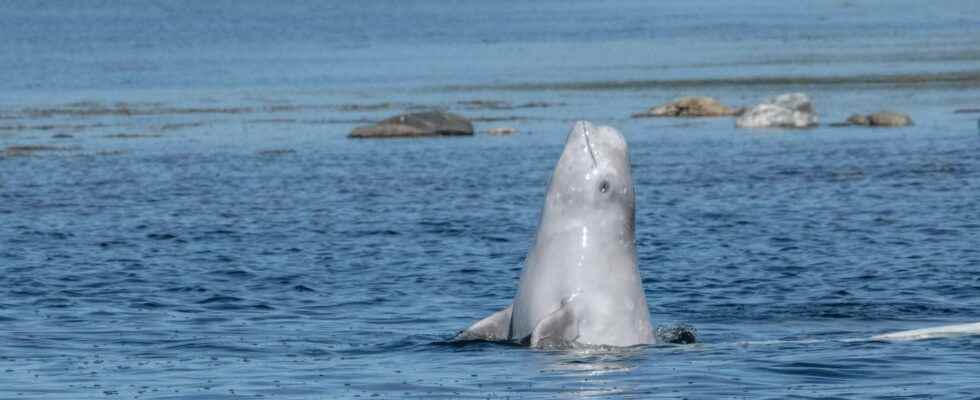Since this Friday evening, the beluga spotted a few days earlier in the Seine has been trapped in a lock about 70 kilometers from Paris. He got in on his own and seems calm. But his state of health worries more and more. He appears notably very emaciated. All attempts to feed him have indeed failed. Even the vitamin injections and products intended to whet his appetite did nothing.
the beluga refuses to eat. According to observers, it dates back several weeks. Well before, therefore, its entry into the Seine. The result, no doubt, of an as yet undiagnosed disease which undermines the chances of saving the animal.
Beluga in the Seine
The animal still does not eat despite the appetite stimulators used by veterinarians. Although very thin, he is alert and dynamic. Euthanasia is therefore ruled out at this stage and repatriation at sea is under consideration. pic.twitter.com/DtNEMF2UCd— Sea Shepherd France (@SeaShepherdFran) August 7, 2022
A difficult rescue
Some also point out that very few rescue operations for lost belugas have so far succeeded. In 2017, an individual was captured in nets in Canada then repatriated by plane and finally transported by truck then brought back by boat from the river — where he got lost — to his natural habitat. It was a happy exception.
Today, the hypothesis of succeeding in helping the lost beluga find its way to the mouth of the Seine seems ruled out. Also discarded, the idea of a euthanasia. As long, however, as the beluga continues to be curious and lively. Even if already, the prefecture of Eure plans to let him end his life quietly “like someone very sick”.
Hopes fading of saving a malnourished beluga whale in the Seine river.
Although rescuers have tried feeding it frozen herring and live trout, the animal has been refusing the food. Rescuers are racing against the clock to find a solutionhttps://t.co/D6pc1cWE0Upic.twitter.com/DlLnB7FUCM
— AFP News Agency (@AFP) August 8, 2022
Perhaps an operation similar to the one carried out in Canada in 2017 could it be imagined? An operation that would be extremely complex to implement, in particular because belugas with their conscious breathing cannot be put to sleep, at the risk of dying. Especially since she would assume that the beluga was treated before being returned to the sea.
Be that as it may, the first emergency now seems to succeed in getting him out of this lock in which he has settled. A hot water pool 125 meters long and only 25 meters wide. Not at all suitable for this animal Arctic 4 meters.
We must save the beluga lost in the Seine
A killer whale, a few weeks ago and now, a beluga. There are really strange things happening in the Seine. And while rescue operations have failed for the orca, the authorities are doing everything they can to put the beluga back on the right track.
Article of Nathalie Mayer published on 05/08/2022
The beluga is a cetacean – a protected species -, a kind of whale, which normally lives in the cold waters of theArctic ocean and in the estuary of Saint Laurent (Canada). Normally. Because it so happens that at the beginning of the week, a beluga was observed swimming in the Seine. Operations coordinated by the prefecture of the Eure department are underway to try to save him.
According to specialists, it can happen that isolated individuals get lost in warmer waters. And they even temporarily survive in fresh water. But this Thursday, the experts dispatched to the site were rather pessimistic. After a meticulous evaluation, the prefecture of Eure evokes a “worrying state of health”. The animal presents “skin alterations and being thinner”. It therefore seems urgent to succeed in feeding the lost beluga. To avoid the sad fate of the killer whale, also lost in the Seine at the beginning of June. She had died of starvation – after, all the same, having taken a bullet in the head…
Press release – ???? Killer whale in Seine-Maritime: Results of analyzes and necropsy ⤵️ pic.twitter.com/3EGGtyJwl3
– Prefect of Normandy and Seine-Maritime (@Prefet76) July 6, 2022
How did a beluga arrive in the Seine?
Because despite everything, the beluga seems to remain toned. The Cotentin Cetacean Study Group (GEEC) describes an animal that performs long apnea in the waters of the Seine. The sign that his lung capacity is not altered. However, this behavior complicates the task of those who would like to guide it to the mouth. For the time being, the beluga would rather tend to flee the boats.
One hypothesis – which remains to be verified, however – would also suggest that it is sound disturbances that are at the origin of the beluga’s wandering. Because this cetacean moves thanks to a sonar natural, which could have been deceived by the noise pollution at the mouth of the Seine.
According to the latest news, the lost beluga was crossing between the Poses dam and that of Saint-Pierre-la-Garenne. That is about 70 kilometers northwest of Paris. It is of course advisable to avoid moving to try to approach it.
Interested in what you just read?
